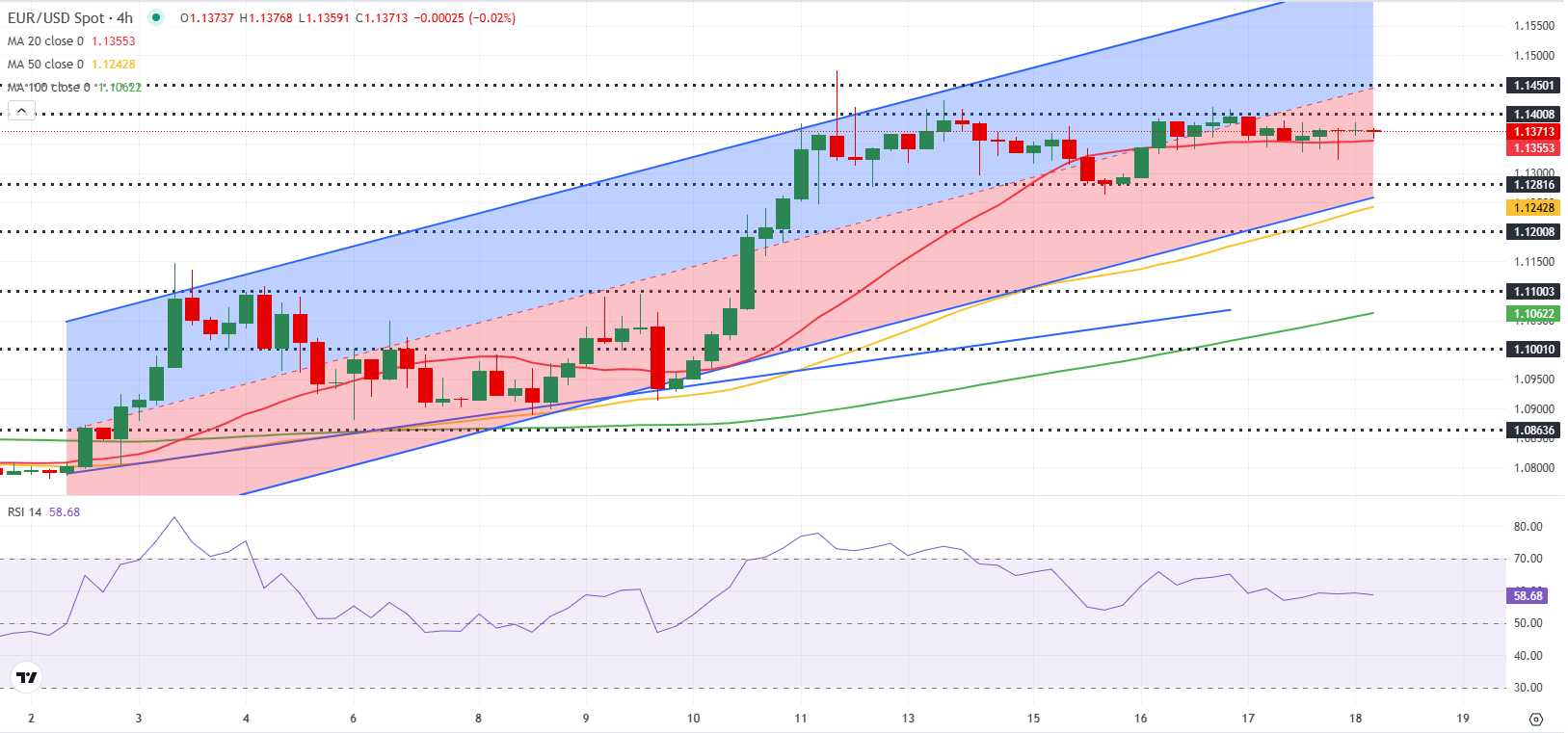EUR/USD Forecast: Euro struggles to stretch higher after ECB
Euro/USD Exchange Rate
The EUR/USD exchange rate traded sideways near 1.1370 on Friday, following Thursday's negative closure. The ECB's 25 basis points rate cut, though in line with expectations, failed to significantly impact the market.
Economic Factors
The Easter holiday kept market activity subdued. The US reported a decline in weekly jobless claims to 215,000, supporting the US dollar. ECB President Christine Lagarde expressed caution about the Eurozone's economic outlook due to uncertainty. ECB policymaker Francois Villeroy de Galhau noted that inflation risks from trade tensions are weak.
Technical Analysis
The 4-hour chart's Relative Strength Index (RSI) hovers slightly below 60, indicating a bullish bias but lacking momentum. Support levels are at 1.1350, 1.1280, and 1.1250, while resistance levels are at 1.1400, 1.1470, and 1.1500.
ECB Actions and Monetary Policy
The ECB's actions and monetary policy decisions, including quantitative easing (QE) and quantitative tightening (QT), have a significant impact on the Euro's value and the overall economy.
- EUR/USD moves sideways in a narrow range above 1.1350 on Friday.
- The pair is likely to remain quiet on Easter Friday.
- The ECB lowered key rates by 25 bps after the April policy meeting.
EUR/USD trades in a narrow channel at around 1.1370 after closing in negative territory on Thursday. With major financial markets remaining closed in observance of the Easter Holiday on Friday, the pair is likely to extend its sideways grind heading into the weekend.
Euro PRICE This week
The table below shows the percentage change of Euro (EUR) against listed major currencies this week. Euro was the strongest against the Swiss Franc.
USD EUR GBP JPY CAD AUD NZD CHF USD -0.04% -1.38% -1.10% -0.14% -1.31% -2.55% -0.06% EUR 0.04% -0.83% -0.62% 0.36% -0.81% -2.08% 0.42% GBP 1.38% 0.83% 0.62% 1.18% 0.02% -1.26% 1.26% JPY 1.10% 0.62% -0.62% 0.95% -0.46% -0.92% 1.17% CAD 0.14% -0.36% -1.18% -0.95% -1.30% -2.41% 0.00% AUD 1.31% 0.81% -0.02% 0.46% 1.30% -1.27% 1.24% NZD 2.55% 2.08% 1.26% 0.92% 2.41% 1.27% 2.58% CHF 0.06% -0.42% -1.26% -1.17% -0.00% -1.24% -2.58%The heat map shows percentage changes of major currencies against each other. The base currency is picked from the left column, while the quote currency is picked from the top row. For example, if you pick the Euro from the left column and move along the horizontal line to the US Dollar, the percentage change displayed in the box will represent EUR (base)/USD (quote).
The European Central Bank (ECB) announced on Thursday that it lowered key rates by 25 basis points (bps) following the April policy meeting. This decision came in line with the market expectation and failed to trigger a noticeable market reaction.
While speaking at the post-meeting press conference, ECB President Christine Lagarde adopted a cautious tone, noting that the Eurozone's economic outlook is clouded by uncertainty.
In the meantime, the data from the US showed that the weekly Initial Jobless Claims declined to 215,000 from 224,000 in the previous week. The US Dollar (USD) held its ground following this data and made it difficult for EUR/USD to gain traction.
Early Friday, ECB policymaker Francois Villeroy de Galhau argued that the inflation risk from trade tensions seems weak and could even be downward, per Reuters.
The economic calendar will not feature any high-tier data releases on Friday.
EUR/USD Technical Analysis

The Relative Strength Index (RSI) indicator on the 4-hour chart moves sideways slightly below 60, suggesting that the bullish bias remains intact but lacks momentum.
On the downside, immediate support is located at 1.1350 (20-period Simple Moving Average) before 1.1280 (static level) and 1.1250 (lower limit of the ascending channel). Looking north, resistances could be spotted at 1.1400 (static level), 1.1470 (midpoint of the ascending channel) and 1.1500 (round level).
ECB FAQs
(The story was corrected on April 18 at 08:16 GMT to say in the first bullet point that EUR/USD moves sideways above 1.1350 on Friday, not Thursday).
🧠 Pro Tip
Skip the extension — just come straight here.
We’ve built a fast, permanent tool you can bookmark and use anytime.
Go To Paywall Unblock ToolSave articles to reading lists
and access them on any device
If you found this app useful,
Please consider supporting us.
Thank you!